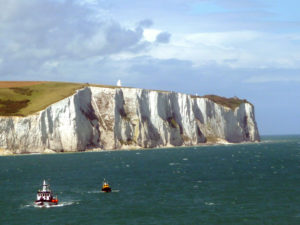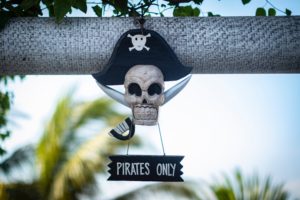Tue 13.03.12:
One of our cranes is broken. This means that yesterday, instead of unloading the 80 containers like we were meant to, we didn’t unload a single one. While the electrician and engineers worked tireless trying to fix the damn thing, I headed back to the island accompanied by the port agent, Chet Tatum (sounds like he should be playing American Football).
Chet was good enough to take me on a proper tour of the entire island in his old jalopy. From the port we headed north along the coast road, past abandoned houses and burnt out stores. On the north end of the island, there’s more of a feeling of what Nauru used to be like, the houses here are better maintained and there’s even some gardens. It’s still a far cry from the neat flower-speckled villages of Samoa, but it’s an improvement on the area around the port. Up there you’ll also find the only real supermarket on Nauru, Chappell’s. The family that own the place have rooms for rent if you’re looking for an alternative to the two hotels that make up the accommodation quotient of this tiny nation.
We followed the coast down to the Menem Hotel – an awful 80s construction, desperately in need of a lick of paint, which is about the best that it you can hope for if you find yourself staying here overnight. In fact, this is the case with every building, every house I can find. They’re all constructed out of cheap n’ nasty concrete and breeze-blocks. There’s no traditional materials, no traditional craftsmanship: this is something I’d expect to see in a third-world city like Accra or Birmingham, but for a country that used to be one of the richest in the world, wouldn’t you expect something a little more, erm, permanent? Or, better yet, beautiful?
Sadly, Nauru’s phosphate boom coincided with precisely the worst decades of architecture in recorded history, so it was either bargain basement tat or bargain basement tat – if only the boom had come in the 1880s instead – people would come from around the world to explore the beautiful and unique sprawling coral-stone mansions of Nauru.
Chet then took me to visit a guy he knows who collects frigate birds. Unlike the Nauruan national dish, noddy bird, they don’t catch frigate birds for food, they catch them to keep as pets. This is a tradition only kept by the people of two countries in the world: Nauru and Peru (which rhyme, wonderfully enough – like Zambia and Gambia, Suriname and Vietnam, France and pants).
This old guy catches these rather large birds, not with a net, but with a lasso. That alone is pretty damn impressive. Each of the island’s clans have their own distinct markings that they put on their birds to show who owns them. Once the frigate bird has been tamed they’re set free and tend not to leave the island ever again.
They tame them by keeping them in a giant cage for a few weeks and feeding them. Eventually, the bird decides that this is a much better way of life than all that flying around being eaten by sharks malarkey and becomes domesticated – you let them out of the cage and they stick around. The problem is you’ve got to feed the buggers and they eat a LOT of fish. Our man here had ten birds – he is recognised as the best frigate bird catcher in the land.
As we chatted under the shade of an old twisted tree, the old man was painstakingly cleaning thousands of fish eggs out of his fishing net – last night’s spawning may have been good for the dolphins, but it had been a nightmare for the fisherman. Although this guy isn’t catching fish for sale, or even for his family, they’re just for his birds. That’s some dedication right there.
After saying our goodbyes to the Bird Man of Nauru, Chet took me alongside the airstrip (like in Tuvalu you can just walk across the damn thing) and then we headed into the interior. We encircled the small lagoon, all that’s left of what millions of years ago would have encompassed the entire interior of the island.
Geologically speaking, Nauru is an interesting little beast. She’s not quite a coral atoll, and she’s not quite a volcanic island: she’s a raised coral island. These things are quite rare, but in a nutshell here’s what (I think) happens..
A volcano pokes its head above the ocean. A fringing coral reef is formed. The volcano sinks, leaving the circular reef shaped like a ring with a lagoon in the middle. So far, so normal. But then, over millions of years, the coral starts to fill in the lagoon as well. Soon you have a circular shallow completely filled in with coral, as though photoshopped.
The volcano continues to sink, and the coral builds up more and more, thicker and thicker, crushing the old dead coral below. Water levels rise and the coral keeps on growing and growing. With the polar ice caps completely melted, the sea level has risen several meters and now our coral reef is struggling to stay in the goldilocks zone in which it can grow – tropical water, no more than twenty metres below the surface. But somehow it pulls it off! So when the ice-caps re-freeze and the sea level drops a perfectly potato-shaped coral island emerges from the brine, looking from beneath the ocean a bit like rock formations of monument valley, only made of coral.
And coral is now pretty much all that’s left. After the lagoon, we went top-side. While a thin strip running around the coast still bears decent vegetation, the central area has been completely de-foliated like there’s been an Agent Orange foam party. With the trees, top soil and phosphate removed, all that remains are these white coral pinnacles upon which little can grow but hardy inedible shrubs. No wonder the birds of the world don’t flock here anymore.
Up past the nation’s rubbish tip are a couple of big guns left by the Japanese. From here you can see the whole island below and you can really get a grip on the devastating environmental effects that one hundred years of phosphate mining has had on this poor bedraggled mess of a nation. My heart goes out to the Nauruans – their tropical island paradise has been trashed, and they haven’t got a dime to show for their sacrifice.
Back on the ship, the crane was still out of order and the crew were getting impatient. Happily, at quarter to one in the morning, Peni, the second engineer burst into the mess, sweating profusely and wearing a big goofy smile. WE DID IT! It’s fixed! Cargo operations would start in the morning.







Most of it is true but Nauru is not as pitiful (or should be pitied) as you make it sound. Are the worldy materials that you described so well on Nauru really that important?! There are alot of things in Nauru that they take for granted but is missing in most developed countries. For example..close knit families and clans, no homelesses, no orphanes, no HIV, no cyclones etc…
I do agree that they have a very big environment problem and are in a reform to get back on their feet due to Political instability and mismanagement.
Otherwise, people are happy, enjoy life without stress of issues that evidently plague other countries and live a life that is unique in most ways.
Such pleasures and experiences you cannot see or feel because you spent a few hours on land. There is more to see, learn and enjoy than meets the eye.
Good point, well made – although the same could be said about almost all the Pacific Islands that I’ve visited!!!